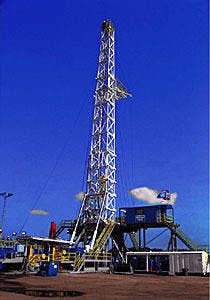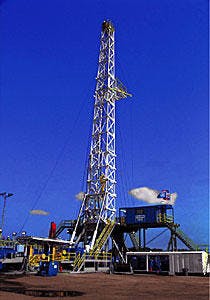"Efficient and capable rigs will get the exploration and development work. Enabling technologies will be critical to an operator´s success."
Drilling rigs that have been renovated with capacity and efficiency enhancements and efficient newbuild rigs will enjoy higher utilization rates in the year ahead and long term.
In mature petroleum basins, oil and gas wells become increasingly difficult to drill and complete as operators are forced to focus on deeper horizons, more difficult to find reserves, and often lower quality reservoir rocks. Much of the reserves produced in the future will be beyond the capability of older, less efficient drilling equipment. Efficient and capable rigs will get the exploration and development work. Enabling technologies will be critical to an operator´s success.
Drilling contractors are currently affected on two fronts: by low commodity prices and by drilling prospects with marginal reserves. New wells to be drilled often have marginal economics, putting pressure on drilling contractors to deliver efficient rigs at economical rates.
Several drilling contractors have highlighted their continuing development and upgrade efforts, even in the face of economic recession and the drilling industry being hammered by low commodity prices, plummeting rig counts, and day rates that are 35% lower than the highs of last year.
Operating company perspectives and development plans shed light on their needs and the drilling industry´s direction in the year ahead.
South Texas gas
El Paso Production Co., Houston, has targeted deep gas exploration, development, and production in South Texas, making it the top operator in the basin, said company Pres. Rod Erskine at a December conference of the International Association of Drilling Contractors (IADC) and Offshore Operators Committee (OOC) in Houston.
The industry has drilled over 300,000 wells in the area, leaving it hard to imagine where an operator could find additional reserves. Erskine said El Paso´s focus on South Texas has surprised a lot of people, because the basin had been declining and there did not appear to be a lot of potential left to drill.
He said that, during basin analysis, El Paso looked beyond the many existing wells, realizing there were only 30,000 wells drilled below 10,000 ft and only 2,500 wells deeper than 15,000 ft.
"In a complex geologic environment like South Texas, 2,500 wells don´t tell you what the geology is really like. You´ve got a basin that´s probably productive to 25,000 ft that´s had very little focus," said Erskine.
Drilling deeper, the rocks become very tight, requiring an entirely new set of technologies to make the formations produce, he said.
Over the past 5 or 6 years, over 65% of the wells that El Paso has drilled or acquired in South Texas are deeper than 10,000 ft. Of the remaining 35% shallower than 10,000 ft, El Paso bought to get the deep mineral rights.
Erskine said, "We seldom ever drill a well shallower than 10,000 ft. In fact this year, our average well depth was 14,500 ft in South Texas."
He said, according to the industry average, companies drill only about 10% of their wells below that depth. El Paso´s initial well production potential in South Texas is almost five times that of the industry.
Massive hydraulic fracturing jobs consisting of 2-4 million lb of proppant for each well make high production rates possible, where initial gas rates can be 25 MMcfd and more.
Erskine explained that the industry had to develop and perfect many technologies to drill and complete these wells, which have bottomhole temperatures of up to 400-420° F and often require 15,000 psi-rated wellheads.
Erskine said El Paso plans to take the technologies that it has learned in South Texas and apply them on the Gulf of Mexico shelf, which he said will be a major challenge.
Erskine said there have been 50,000 wells drilled on the shelf, but only 2,500 wells were drilled below 15,000 ft and only 700 below 17,000 ft. This basin should be productive to at least 30,000 ft and possibly even to 40,000 ft, because the temperatures are lower than what prevails in South Texas, he added.
Rig capabilities and technology will clearly evolve as the industry extends over time down to a 30,000 or 40,000-ft economic basement.
Deep shelf
Bob Meize, division drilling manager, offshore drilling department, for Anadarko Petroleum Corp., Houston, told the IADC-OOC conference that his company has pioneered Gulf of Mexico subsalt drilling and exploration in an area known as the subsalt fairway.
The subsalt fairway extends from the middle of the West Cameron South addition on the west and to the mid-Mississippi Canyon? addition on the east, covering 1,000 blocks that are in 200-3,000 ft of water.
Meize said Anadarko has been working in the area for over a decade and has made seven major discoveries. The company currently has 20 new subsalt prospects and also is looking to drill several high potential subsalt wells in deepwater, he said.
The industry´s ability to drill these wells to 20,000 ft and meet the engineering challenges associated with these depths is critical to its success, said Meize.
He noted the large amount of unexplored acreage left on the shelf, with only 25 tests below 20,000 ft.
Meize commented that about two thirds of the gulf is covered with salt and that relatively few penetrations to the subsalt environment have been evaluated.
"The challenge for producers like Anadarko is to continue pushing technologies that drive this deep exploration and to figure out more creative, cost-effective ways to exploit what we find," said Meize.
He said the main challenge for drilling contractors is to supply the right hardware and people to meet operators´ needs with more powerful rigs, capable of drilling to deep targets. We need to set out to reach these objectives, Meize noted, but the drilling effort also needs to be secured at a reasonable price. A lot of these prospects are still very sensitive to high drilling costs, he added.
Land rigs
A prime example of drilling contractors working to expand rig fleet capabilities and enhance drilling efficiency are the newbuild land rigs commissioned in 2001 by Helmerich & Payne IDC, Tulsa, and Pioneer Drilling Co. Ltd., San Antonio.
In August, Pioneer Drilling mobilized the first of two new IRI 1700E series rigs to spud its first well. Believed to be the first application of AC-drive drawworks on a US land rig, the unit is designed for 18,000 ft and includes a specially designed mud system, enclosed driller´s cabin, and programmable logic control systems.
H&P began its newbuild program in 1998, when it introduced its first rigs with a modular design for efficient rig-up and rig-down and a capability to move with fewer loads.
After the first six rigs were commissioned, H&P upgraded the design to include climate-controlled driller´s cabins, larger mud pumps, and a V-ICIS electronic operating system on touch screen. The company has 12 of these second-generation "flexrigs" on order, the first of which have been delivered.
H&P plans to build 25 more units in 2002 that will feature 25-ft substructures, redesigned derricks, and AC-drive regenerative braking drawworks, for delivery by March 2003.
John Lindsey, vice-president of US land drilling for H&P, said the design changes between the second and third generations of the newbuilds would be dramatic. He said the company has decided to design its own mast and substructure. As wells get deeper, the rig substructure must accommodate larger BOP stacks, he added.
Lindsey said the company is looking at BOP handling systems that would allow fully assembled and pressure-tested BOP stacks to be moved into the substructure and onto the well.
Experiencing lower rig rates like everyone else in the industry, Lindsey said H&P´s rig rates are down from highs earlier this year by 20-30%, depending on the type and size of the rig.
He said, however, that his company would continue with plans to build the 25 new rigs, adding that H&P´s new rig designs have averaged 94-95% utilization since the original rigs were introduced in 1998.
Even in the midst of the current drilling industry down turn, Lindsey said H&P has adequate access to capital, allowing it to continue with the rig newbuild program.
He said, "These advanced-technology rigs command a premium. They are very competitive both internally and against the industry."
Big jack ups
Danny McNease, executive vice-president, Rowan Cos. Inc., Houston, at the IADC-OOC conference highlighted some of the things that contractors can do to lower the cost of drilling deep shelf wells in the Gulf of Mexico.
He reviewed a hypothetical case of upgrading a LeTourneau 116-class jack up, giving it the capability of drilling a deep shelf well to more than 20,000 ft. McNease said, initially, the task appears easy, by replacing the derrick and a few other things on the rig.
Upon further engineering review, he added, the cantilever had to be replaced, to give the rig a 1.5 million lb hook load. After the complete upgrade, the contractor ends up with a $100 million, 17-year-old rig with insufficient variable deck load, said McNease.
He said his company went back and looked at what the next shallow-water rig would look like. Rowan came up with what it calls the Tarzan class rig (OGJ, Oct. 8, 2001, p. 42).
Capable of drilling in 250 ft of water, the rig will have 9,000 hp of mud pump capacity, 2 million lb hook load, and variable deck load of 7 million lb, adequate to drill well past 15,000 ft TVD.
Deepwater
The technology of dual-gradient drilling became a reality in November 2001, when the SubSea MudLift Drilling joint-industry project (JIP), led by Conoco Inc., Houston, demonstrated its system during actual drilling operations in the Gulf of Mexico.
Ken Smith of Conoco said the system drilled the world´s first dual gradient well, No. 8 in 910 ft of water in Shasta field on Green Canyon Block 136, operated by Texaco Inc..
The Ocean New Era, owned by Diamond Offshore Drilling Inc., Houston, drilled the well, demonstrating that the mud-lift pumping system could be integrated into an older, second-generation, semisubmersible rig.
Smith said the JIP would now proceed with trying to commercialize the technology. He said the system, which cost $50 million to develop, would have to be commercialized on the basis of doing a group of wells.
Other, competing, dual-gradient concepts are still in the minds of engineers. Shell Exploration & Production Co., Houston, is working on its own version of dual-gradient drilling.
Shell´s is based on separating the larger drill cuttings from the mud at the sea floor and pumping the mud back to the rig with submersible centrifugal pumps. The company plans to have a working prototype by yearend.
A JIP led by Houston-based Maurer Technology is working on a third concept involving very small gas-filled glass beads that can be injected into the mud stream, returning from the sea floor.
In addition to a strictly dual-gradient system, the JIP is looking at possibilities of affecting the mud gradient below the mud line.
William Maurer, president of Maurer Technology, said it is possible to design multiple gas sphere injection points into the returning mud, giving wells a variable mud gradient that follows the safe zone between pore pressure and fracture gradient.
Dual-gradient drilling is only one example of the broad array of drilling technologies to keep an eye on. The year ahead will reveal where the industry takes the next incremental technological step.



